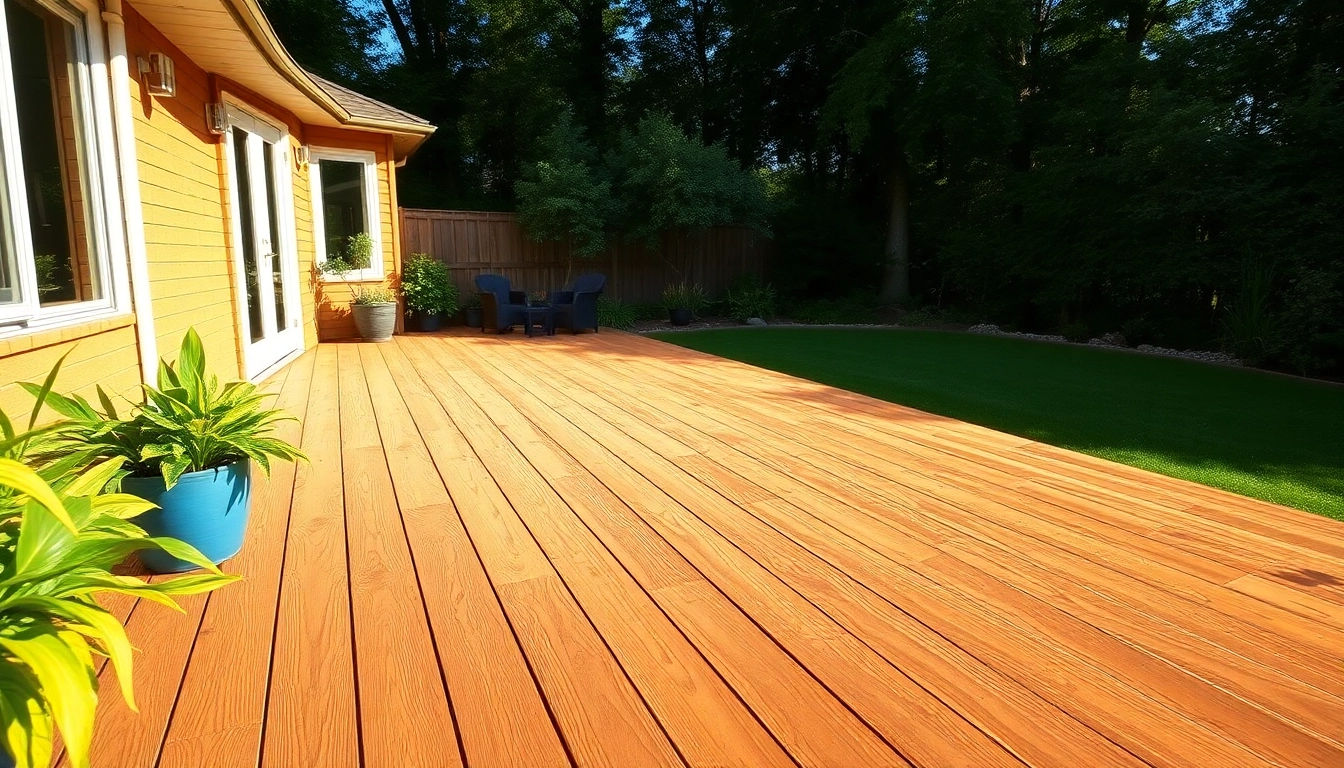Understanding Deck Construction Basics
What is Deck Construction?
Deck construction involves the process of designing and building a structure that extends from a building or an outdoor area, typically made of wood, composite materials, or other durable substances. Decks serve various purposes, such as providing a space for outdoor activities, enhancing a home’s aesthetic appeal, or increasing property value. Understanding the fundamentals of deck construction is crucial before embarking on a project, as it encompasses structural integrity, material selection, and local building codes.
Common Deck Materials
The selection of materials plays a significant role in both the longevity and appearance of a deck. Common materials include:
- Pressure-Treated Wood: This is the most popular option, known for its affordability and resistance to decay. It’s treated with chemicals to withstand moisture and pests.
- Cedar and Redwood: These species are naturally resistant to rot and insects, providing excellent durability, although they can be more expensive than pressure-treated wood.
- Composite Materials: Composed of a mix of wood fibers and plastic, composites require less maintenance and are available in a variety of colors. However, they may not have the same structural strength as wood.
- Aluminum: Lightweight and extremely durable, aluminum decking is weather-resistant and won’t warp or splinter, but can be pricier.
Importance of Building Codes
Adhering to local building codes is vital for deck construction. These regulations ensure that structures are safe, accessible, and structurally sound. Local codes typically govern aspects such as:
- Deck height and load capacity
- Material specifications
- Permit requirements
- Safety features like railings and stairs
Consulting the local building authority or a professional contractor can help ensure all legal requirements are met and help avoid future complications. For a thorough understanding of how to navigate deck construction while adhering to these codes, refer to deck construction regulations in your area.
Planning Your Deck Construction Project
Choosing the Right Location
The location of your deck is critical and should be determined based on accessibility, sunlight, temperature, and view. Consider the following:
- Sunlight Exposure: Decide whether you want a sun-soaked deck or a shaded retreat. This affects the choice of materials and the design.
- Privacy: Evaluate how much privacy you desire, and if necessary, consider landscaping or barriers to enhance seclusion.
- Proximity to the House: Ensure easy access to your home, possibly integrating doors or steps for fluid movement between spaces.
Designing Your Deck Layout
A well-thought-out layout can make your deck more functional and aesthetically pleasing. Here are some design principles to keep in mind:
- Zoning: Allocate areas for different activities, such as dining, lounging, or barbecuing. This can help create a natural flow.
- Shape and Size: Choose between traditional rectangles or more elaborate shapes that complement your home’s architecture.
- Visual Enhancements: Incorporate features such as built-in benches, planter boxes, or railing designs to enhance visual interest.
Estimating Costs and Budgeting
When planning your deck, it’s essential to have a clear budget that takes into account material costs, labor, and extras like furnishings and landscaping. A rough estimate per square foot can range widely depending on materials:
- Pressure-Treated Wood: $15-$30 per square foot
- Cedar/Redwood: $30-$50 per square foot
- Composite: $20-$45 per square foot
- Aluminum: $40-$70 per square foot
Keep a margin for unforeseen expenses and consider whether to opt for a DIY project or hire professionals, as this can significantly affect cost.
Step-by-Step Deck Construction Process
Preparing the Site
The construction site must be prepared before building begins. This involves clearing the area of debris, vegetation, and grading the ground to ensure proper drainage. Setting up barriers may also be necessary to protect surrounding areas during construction.
Installing the Foundation
The foundation is crucial for the stability of your deck. Common methods include:
- Concrete Footings: These are poured to support posts and should be below the frost line in colder regions.
- Post Anchors: Use embedment anchors for securing posts in efficient and stable footing.
- Block and Pier Foundations: For elevated decks, using concrete blocks or piers can provide the necessary support.
Framing the Deck Structure
Once the foundation is set, the framing process begins:
- Install Ledger Board: This board affixes to the house and provides support for the deck structure.
- Outer Joists: Secure these to the ledger board and additional supports to outline the perimeter of the deck.
- Inner Joists: These are spaced typically 16 inches apart to provide stability and do not compromise the deck’s load capacity.
Finishing Touches in Deck Construction
Choosing Decking Options
Selecting the right decking material is essential for durability and maintenance:
- Wood Decking: Often celebrated for its natural beauty, wood requires regular sealing and staining to withstand the elements.
- Composite Decking: This is lower maintenance with no need for staining, but can be susceptible to fading over time.
- Vinyl Decking: Highly resistant to moisture and mildew, offering a wide range of colors and styles.
Adding Railing and Stairs
Properly designed railings and stairs not only enhance safety but also contribute to the aesthetic appeal:
- Railing Heights: Ensure they are compliant with local codes, usually standing 36 to 42 inches above the deck surface.
- Stair Design: Steps should ideally have a rise between 4 and 7 inches and a tread width of at least 10 inches for safety.
Surface Treatments and Maintenance
To maintain your deck’s integrity and appearance, consider these treatments:
- Sealants: Apply sealants on wood decks to protect against moisture, mildew, and UV damage.
- Stain: Regularly staining wooden surfaces not only protects but also enhances the natural color and beauty of the wood.
- Cleaning: Regular inspection and cleaning can prevent build-up and damage. Use a soft bristle brush and avoid harsh chemicals.
Maximizing Your Deck Construction Investment
Enhancing Outdoor Living Spaces
Decks can serve as extensions of your living space, providing room for outdoor furniture, grills, or even decorative features like outdoor rugs and lighting. Enhancing the outdoor living experience can involve:
- Creating Separate Zones: Designate areas for dining, relaxing, and cooking. This adds functionality and appeal.
- Incorporating Shade Structures: Pergolas or canopies can extend usability during hot weather.
Incorporating Landscaping Ideas
Integrating landscaping can enhance the beauty of your deck. Consider the following:
- Planters: Incorporate flower beds or potted plants to add color and soften the deck’s edges.
- Access to Nature: Connect your deck to outdoor paths or gardens to encourage outdoor activities.
Resale Value and Boosting Property Appeal
A well-constructed deck can significantly increase your property’s value. Studies show that homeowners recoup between 70% to 80% of their investment in a new deck. It appeals to potential buyers looking for functional outdoor living spaces.
For maximum return, ensure your deck is well-maintained and stylistically appealing. Consider standard designs and materials that are in demand, as this can greatly enhance your home’s marketability.








